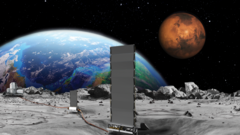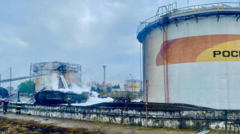NASA's latest plan to develop a nuclear reactor on the Moon by 2030 is part of a broader strategy to create a sustainable human presence on the lunar surface, acknowledging the urgency posed by global rivals China and Russia in the new era of space exploration.
NASA's Ambitious Plan to Establish a Nuclear Reactor on the Moon by 2030

NASA's Ambitious Plan to Establish a Nuclear Reactor on the Moon by 2030
US space agency sets sights on permanent lunar base amid escalating international space competition.
NASA is moving forward with plans to construct a nuclear reactor on the Moon by 2030, a decision underscored by recent media reports that highlight the urgency of establishing a permanent human base on the lunar surface. Amid fierce competition from global space powers such as China and Russia, the United States aims to solidify its presence on the Moon, with concerns that rival nations could delineate territory that would hinder exploration and development.
According to Politico, Sean Duffy, the temporary head of NASA, emphasizes the need for rapid advancements in energy generation to support lunar activities and safeguard national security in space. He has called for proposals from commercial entities to develop reactors capable of producing at least 100 kilowatts of power, a relatively modest figure considering modern energy demands.
The concept of utilizing nuclear power on the Moon has been under consideration for some time. Last year, NASA awarded contracts totaling $15 million to various firms to devise designs for lunar reactors. In a competitive response, both China and Russia have proposed constructing an automated nuclear power station by 2035.
Experts believe a nuclear reactor is crucial for ensuring a reliable energy source on the Moon, as solar power alone is inadequate due to the Moon's day-night cycle, which comprises two weeks of sunlight followed by two weeks of darkness. Dr. Sungwoo Lim from the University of Surrey argues that nuclear energy is not just advantageous but essential to establish a sustainable lunar economy.
While some scientists see the project as technically feasible given enough funding, the reality of launching radioactive materials poses safety challenges. Dr. Simeon Barber from the Open University raised concerns about the safety regulations governing the transportation of such materials.
The recent announcement from NASA follows significant budget cuts of approximately 24% that were imposed by the Trump administration, leading to uncertainty around critical projects such as the Mars Sample Return initiative. Concerns also linger regarding whether this accelerated nuclear initiative is politically motivated amidst renewed international competition in space.
Duffy's remarks about China's and Russia's potential to establish restricted areas on the Moon reference the Artemis Accords, an agreement signed by seven nations to promote cooperative lunar exploration and outline safety zones around country-specific operations. Critics argue that these moves could foster a sense of territorial ownership of lunar resources, diverting focus from collaborative scientific exploration.
Despite aiming to send astronauts to the lunar surface by 2027 through its Artemis 3 mission, many hurdles remain to ensuring that the necessary infrastructure and transportation capabilities are established in tandem with the reactor's development.
As nations ramp up their ambitions for lunar exploration, the question of who ultimately "owns" parts of the Moon intensifies. The concept of safety zones, driven by initiatives like the nuclear reactor, could edge toward claims of sovereignty, reshaping the landscape of lunar exploration for years to come.
According to Politico, Sean Duffy, the temporary head of NASA, emphasizes the need for rapid advancements in energy generation to support lunar activities and safeguard national security in space. He has called for proposals from commercial entities to develop reactors capable of producing at least 100 kilowatts of power, a relatively modest figure considering modern energy demands.
The concept of utilizing nuclear power on the Moon has been under consideration for some time. Last year, NASA awarded contracts totaling $15 million to various firms to devise designs for lunar reactors. In a competitive response, both China and Russia have proposed constructing an automated nuclear power station by 2035.
Experts believe a nuclear reactor is crucial for ensuring a reliable energy source on the Moon, as solar power alone is inadequate due to the Moon's day-night cycle, which comprises two weeks of sunlight followed by two weeks of darkness. Dr. Sungwoo Lim from the University of Surrey argues that nuclear energy is not just advantageous but essential to establish a sustainable lunar economy.
While some scientists see the project as technically feasible given enough funding, the reality of launching radioactive materials poses safety challenges. Dr. Simeon Barber from the Open University raised concerns about the safety regulations governing the transportation of such materials.
The recent announcement from NASA follows significant budget cuts of approximately 24% that were imposed by the Trump administration, leading to uncertainty around critical projects such as the Mars Sample Return initiative. Concerns also linger regarding whether this accelerated nuclear initiative is politically motivated amidst renewed international competition in space.
Duffy's remarks about China's and Russia's potential to establish restricted areas on the Moon reference the Artemis Accords, an agreement signed by seven nations to promote cooperative lunar exploration and outline safety zones around country-specific operations. Critics argue that these moves could foster a sense of territorial ownership of lunar resources, diverting focus from collaborative scientific exploration.
Despite aiming to send astronauts to the lunar surface by 2027 through its Artemis 3 mission, many hurdles remain to ensuring that the necessary infrastructure and transportation capabilities are established in tandem with the reactor's development.
As nations ramp up their ambitions for lunar exploration, the question of who ultimately "owns" parts of the Moon intensifies. The concept of safety zones, driven by initiatives like the nuclear reactor, could edge toward claims of sovereignty, reshaping the landscape of lunar exploration for years to come.



















